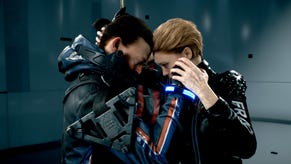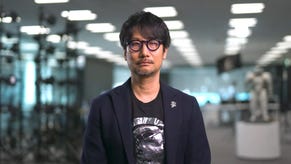Death Stranding performance analysis: PS4, PS4 Pro and the day one patch tested
Platform parity?
Last week, we published our detailed tech review of Death Stranding, focusing on the PlayStation 4 Pro version of the game. It's fair to say that in terms of its technological achievements, this is indeed a defining benchmark for the current wave of console hardware - but at the tail-end of the generation, the base PS4 hardware has been pushed hard by many developers. Perhaps too hard. The question is, how does Death Stranding on the standard PlayStation 4 hold up?
We can put yours mind at rest. Based on the code we've had in our hands for a few weeks now, the answer is remarkably straightforward. Similar to its Decima Engine stablemate, Horizon Zero Dawn, the Kojima Productions debut offers a remarkable level of parity between base and enhanced consoles. The main factor of differentiation is indeed the native rendering resolution. There are few surprises here: Death Stranding operates at 1080p on the vanilla PS4, rising to a checkerboarded 2160p on the Pro.
Everything else about the game's visual make-up is a lock between both systems, meaning that the entire Death Stranding experience is effectively feature-complete on vanilla hardware. Or to put it another way: everything we enjoyed about the game in our initial coverage applies equally across the PlayStation 4 family of consoles - and that extends to performance as well, where the latest patch 1.04 actually serves to improve the minor frame-rate dips we saw on the Pro during initial testing. By and large, both versions of the game run at 30 frames per second and where there are some dips, they seem to play out in much the same way. In fact, in very, very limited scenes, you may even see the standard PS4 marginally outperform the Pro.
It's still the case that performance drops - such as they are - are limited mostly to non-interactive engine-driven cutscenes, while our tests so far have offered up pretty much rock-solid in-game performance, to the point where we've run performance analysis software in the background during much of our playthrough of the entire game. The end result? Finding deviation from the target frame-rate is very, very challenging indeed. It seems that there is a slight bias more towards visual fidelity in cutscenes vs consistency in performance - but overall, there's very little to criticise here.
On top of that, the Pro has an ace in the hole. Horizon Zero Dawn shipped with two graphics modes for the 'super-charged' PS4: resolution and performance. The former delivered excellent 4K checkerboarding, while the latter stuck to native rendering resolution with a focus on a rock-solid frame-rate (Guerrilla later told us that 1368p was the sweet spot it settled on (Correction: previous version of this article stated 1365p). Death Stranding seems to offer similar or the same functionality - but without the in-game option to choose. Setting the Pro to 2160p output delivers checkerboarding, while a 1080p selection on the machine's front-end instigates Death Stranding's equivalent performance mode, eliminating every performance drop we could find in the game. However, if you're a Pro 1080p user who'd prefer super-sampling down from 2160p, using the system level option does that job just fine.
Moving on, we decided to look back at Death Stranding's various showings from its E3 2016 debut to its 2019 release. It's an exercise we enjoy carrying out to get some idea of how specific titles evolve over time, but what's remarkable about Kojima Productions' debut is how consistent the presentation has been in all published media over the last three-and-a-half years and the implications this has for how the game was made.
Returning to the initial E3 2016 teaser, many of its scenes are perfectly represented in the final game, right down to animation and nigh-on identical camera positioning. At the time, Hideo Kojima was still apparently travelling the world in search of the definitive game engine technology to bring this enigmatic vision to life - but the final game is so similar to that initial teaser, we wouldn't be surprised at all if Decima was already a lock - or at least, that Decima was used to create the teaser while Kojima still mulled over the options.
There are obvious improvements, including superior water rendering, a more realistic Norman Reedus model and better lighting. However, the overall aesthetic remains very, very similar and in terms of actual content, what Kojima showcased back in 2016 is effectively unchanged right up until the present day. Fast forward to The Game Awards 2017 and Decima is confirmed, with the content looking almost identical to the same scene in the final shipping release. Yes, there are minor artistics flourishes added, a shift in lighting and the odd asset change - but over two years prior to release, we have a sequence that would sit comfortably in the final game. In fact, cutscene direction - with just slight camera tweaks - and even audio are a match for the code that ships today.
It all speaks towards a singular vision that Kojima Productions targeted and achieved in what we assume to be a four-year development cycle, with the studio and Sony confirming its colloboration in December 2015. Bearing in mind the logistics in recruiting and forming a new development house, delivering a game as advanced and as polished as Death Stranding is quite remarkable.
And perhaps the fact that we are reaching the tail-end of this console generation plays a part in all of this. Death Stranding sees obvious and impressive improvements to the Decima Engine, but those earlier media reveals also demonstrate that much of what Kojima Productions and Guerrilla Games wanted to deliver was seemingly in place production-wise by December 2017. It may well be that this firm technological foundation played a key role in allowing the team to concentrate more fully on delivering the experience it wanted to make. That game is available to buy today. It was exceptional when we checked it out during the review phase and the patch updates since then have added further polish. We highly recommend checking it out.











